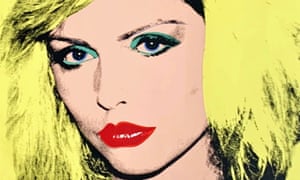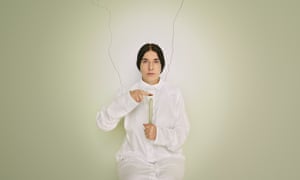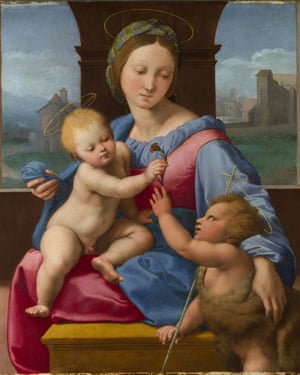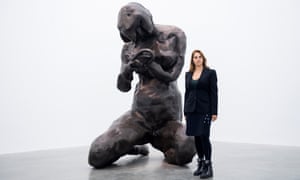정준모
Palette cleansers: our photography, art and architecture picks for 2020
Warhol is revealed as a prophet, London goes down the rabbit hole and Don McCullin takes his masterworks to Merseyside
by Adrian Searle, Jonathan Jones, Oliver Wainwright and Sean O’Hagan
Picasso and Paper
Paper wasn’t just something to draw on for Picasso – it was yet another material he could manipulate. That effortless creativity started with sticking newspapers on to early cubist canvases to invent collage and evolved into his own style of playful origami sculpture – yet he also found time to create some of the greatest etchings ever, including the wondrous Vollard Suite, with its minotaurs, bullfights and voluptuous lovers.
Royal Academy, London, 25 January to 13 April
Van Eyck: An Optical Revolution

Jan van Eyck. Photograph: Kunsthistorisches Museum Vienna
Ghent honours the greatest painter of the early northern Renaissance with numerous exhibitions and side-events, from the scholarly to the daft – including floral displays, themed food events, a Van Eyck shop, and even the Jan van Eyck Marathon. The main event however is Van Eyck: An Optical Revolution, featuring at least half of the known works by the artist and including the outer panels of Hubert and Van Eyck’s astonishing Ghent Altarpiece, following six years of restoration, and also including more than 100 works by Van Eyck’s contemporaries from across Europe.
Museum of Fine Arts, Ghent, 1 February to 30 April
Radical Figures
By the end of the last century, painting had been buried but it turns out the funeral was premature. The young 21st-century artists exhuming its oily corpse in this survey include Michael Armitage, whose subtle, complex paintings draw on memories of Kenya, and Ryan Mosley, whose art is a grotesque Dada carnival of bulbous humanoid forms. This is figurative painting, but not as we know it.
Whitechapel Gallery, London, 6 February to 10 May
We Will Walk – Art and Resistance from the American South

An ongoing story … Ralph Griffin’s Eagle, part of the We Will Walk exhibition. Photograph: © Estate of Ralph Griffin/ Artists Rights Society/ New York
Bringing together artists, civil rights photographers, makers of quilts, guitars (one fashioned with wood from a hanging tree), assemblages, expansive archive material, music and much more besides, We Will Walk focuses on African-American artists from Alabama and the surrounding states. The work dates from the civil rights period and its aftermath to the present day and also features the work of contemporary artists and thinkers, including Kerry James Marshall and Angela Davis, who both migrated from Alabama. It is a story that isn’t over, and not told enough.
Turner Contemporary, Margate, 7 February to 3 May
Steve McQueen
In his film Hunger, perhaps his finest work, McQueen homes in on the dying, emaciated body of the IRA hunger striker Bobby Sands in a way that evokes both Christian paintings of the passion and Sands’s identification with them. It’s typical of the way he brings high art into cinemas as well as film-making into the gallery. How will this retrospective capture the unique achievement of the only person to win both an Oscar and a Turner prize?
Tate Modern, London, 13 February to 11 May
Linderism
Performance artist, zine maker, musician, documentary-photographer, Linder is known primarily for her post-punk Dadaist photomontages. This extensive show gives full reign to Linder’s expanded practice. Using the Kettle’s Yard Archive she will also evoke the elusive presence of Helen Ede, wife of Jim Ede, founder of Kettles’s Yard. Staging interventions throughout Kettle’s Yard and a new performance, at Murray Edwards College, Cambridge, Linder will shake things up.
Kettle’s Yard, Cambridge, 15 February to 16 April
Aubrey Beardsley

Beautiful yet utterly sordid … The Yellow Book by Audrey Beardsley. Photograph: © Tate
Victorian Britain’s kinkiest reprobate gets a well-deserved airing of his refined and beautiful yet utterly sordid prints. Beardsley portrayed himself as a self-confessed “monster” hiding in his four-poster bed and illustrated Lysistrata by Aristophanes with sumptuously pornographic images of bottoms. He also created a darkly beautiful illustrated edition of Oscar Wilde’s Salome. This will be wicked.
Tate Britain, London, 4 March to 25 May
Among the Trees
Tacita Dean’s portraits of ancient yew trees in English churchyards, their branches propped up with crutches as their gnarled trunks send roots down the centuries, are among the most moving art works of our time. Her arboreal meditations are among the many reveries in this survey of contemporary art’s relationship with trees. It starts with the arte povera movement that brought the forest into the gallery in the 1960s and brings us to the present with Peter Doig’s painted firs and Anya Gallaccio’s pastoral installations.
Hayward Gallery, London, 4 March to 17 May
Andy Warhol

‘Radically popular’ … Andy Warhol’s image of Debbie Harry (1980). Photograph: © Andy Warhol Foundation for the Visual Arts, Inc / Artists Right Society, New York and DACS, London
In his lifetime Warhol was dismissed as shallow but the further we get into a century he never lived to see, the more uncanny his insights into modern life appear. There are so many sides to his apparently simple pop art. The last Tate retrospective emphasised his dark view of America – this one discovers him as the forerunner of identity politics. He is our mirror, to quote his protege Lou Reed.
Tate Modern, London, 12 March to 6 September
Titian: Love, Desire, Death
This once-in-a-lifetime exhibition reunites the greatest mythological paintings ever created – a cycle Titian called his “poesie” in which the loves and transformations of the gods become subtle feasts of sensual paint and rich emotion. Venus begs Adonis to stay, Jupiter as a bull carries off Europa and Perseus rescues Andromeda in canvases that match the dramatic heights of Shakespeare (and that Shakespeare may have been influenced by).
National Gallery, London, 16 March to 14 June
Toyin Ojih Odutola
The gallery becomes an outsized graphic novel in this Nigerian-American artist’s first British show – but the story is far from straightforward. Powerfully delineated figures are lost in contemplative stillness. Line-drawn landscapes enfold their inaction in a mysterious limbo that could be a park or alien planet. These intense drawings illustrate a myth invented by Odutola herself. She believes drawing and writing have the same root. This is art as inspired daydream.
Barbican Curve, London, 26 March to 26 July
Artemisia Gentileschi

Blockbuster … Artemisia Gentileschi’s Self-Portrait as a Lute Player. Photograph: © Wadsworth Atheneum Museum of Art
The first feminist artist ever, born in Rome in 1593, gets her long-awaited due. Raped as a teenager by the painter Agostino Tassi, Gentileschi spent a lifetime fighting back. In her great canvas Judith Slaying Holofernes, two women hold a man down on his bed so they can cut his head off – he is her rapist. This and just about all her other paintings will be in this raw and bloody blockbuster.
National Gallery, London, 4 April to 26 July
Back to Earth
To mark its 50th anniversary, the Serpentine Galleries have invited more than 50 leading artists, musicians, architects, poets, film-makers, scientists, thinkers and designers to propose artworks and projects in response to the climate emergency. Participants and collaborators include Brian Eno, Black Quantum Futurism collective, Judy Chicago, Olafur Eliasson, actor and activist Jane Fonda, indigenous Australian film collective Karrabing, Ed Ruscha, Tomas Sarraceno and many others. Imagining the future, the unthinkable and the possible, this promises to be a daunting, necessary show.
Serpentine Galleries, London. Dates to be confirmed.
Candice Breitz: Love Story

Giving migrants a voice … Stills from Love Story. Photograph: Candice Breitz
Alec Baldwin and Julianne Moore bring a Hollywood touch to the plight of refugees by reading out their words. Wait – it’s not as glib as it sounds. This installation by South African artist Breitz questions why we take celebrities more seriously than the suffering millions. Moore and Baldwin’s polished performances are meant to send you to the second part of the show that gives migrants a direct voice.
Tate Liverpool, 9 April to 7 June
Ray Harryhausen

Harryhausen’s Medusa from Clash of the Titans. Photograph: © Ray and Diana Harryhausen Foundation
No one forgets the myths and monsters this genius of art and cinema created. Harryhausen’s animated masterpieces, from the army of skeletons in Jason and the Argonauts to Sinbad’s swordfight with a Hindu goddess, have an imaginative power that lodges in your mind. He was equally at home creating flying saucers, giant crabs and Harpies. This blockbuster survey of his stop-motion menagerie should be a delight.
Scottish National Gallery of Modern Art, Edinburgh, 23 May to 25 October
Arctic: Culture and Climate
Sign up to the Art Weekly email
Read more
The Arctic is not just a natural wonder but a human home. Peoples including the Sámi of Scandinavia’s far north and the Inuit in Canada, Alaska and Greenland preserve ways of life superbly adapted to ice and cold. Their cultural creations include ingenious hunting and fishing gear, icebound legends and works of art. Their achievement has been to live in harmony with nature at its most extreme – but as climate change destabilises the Arctic, what will become of this extraordinary heritage?
British Museum, London, from 28 May
Heather Phillipson: The End
The maquette for The End, Phillipson’s forthcoming commission for Trafalgar Square’s fourth plinth, shows a gigantic ice-cream cone with a cherry on top. A fly climbs the swirl of ice-cream and there’s a drone, ready for take off. It’s a tawdry monument to national hubris, the feelgood factor turning sickly before our eyes. Phillipson’s work churns with humour, autobiography, knockabout asides and a poet’s sense of the unlikely and surprising conjunction. Then in June, the artist fills Tate Britain’s Duveen galleries with the next Tate Britain commission. What will she do?
Trafalgar Square, London, March, and Tate Britain, London, 16 June to 18 October
Sheila Hicks

Ravishing … Saffron Sentinel. Photograph: Noam Preisman/© Sheila Hicks/courtesy of Alison Jacques Gallery
The Paris-based American artist has used weaving as the basis of her work for more than 50 years. Drawing on wildly different weaving traditions and indigenous textile practices, and working on both small woven drawings she creates on a hand-held frame and large scale installations that respond to the architecture of the gallery, this show follows major retrospectives in the US and Europe. Including more than 70 works, it promises to be as ravishing as it is overdue. The Hepworth is a perfect venue for her art.
The Hepworth, Wakefield, 24 June to 7 October
Alice: Curiouser and Curiouser
Lewis Carroll’s Victorian masterpiece of surreal nonsense has inspired art and cinema ever since Punch cartoonist Sir John Tenniel created its brilliant original illustrations with their solid renditions of the fantastic. Jan Svankmajer and Tim Burton are among the modern visionaries to have fallen down this rabbit hole. The V&A isn’t just showing the history of Alice, it’s giving Carroll the Bowie or Pink Floyd treatment with an “immersive” spectacular where you can ask Alice what the Dormouse said.
V&A, London, 27 June to 10 January 2021
Liverpool Biennial 2020: The Stomach and the Port
Now in its 11th outing, the Liverpool Biennial thinks about the city and a wide range of interrelated exhibitions as a fluid organism that is continuously shaped by and shaping its environment. The curatorial premise talks about three entry points – the stomach, porosity and kin. Make of this what you can. Many of the art works include sound, shun direct representation, destabilise gender binaries or look at intense forms of contact. There will be dance, music, all kinds of interdisciplinary shenanigans from a roster of international artists. If you have the stomach, pass the port.
Various venues, Liverpool, 11 July to 25 October
Cézanne: The Rock and Quarry Paintings
The craggy hard mind of Paul Cézanne found its mirror in the rugged rock formations of his native Provence. One of his close friends as a boy in Aix grew up to be a geology professor and their conversations about rocks and fossils informed his understanding of landscape. His paintings of lonely sun-bleached stony hillsides and voids cut into the earth are among his most forceful, profound and unforgettable works. This is where modern art begins.
Royal Academy, London, 12 July to 18 October
British Art Show 9
We’ve come a long way from British art’s past. By which I mean the 1990s, when shock and celebrity were everything. Politics, identity and social media matter more than elephant dung these days – or will that cliche about 21st-century British art be disrupted in turn by this latest instalment of the biggest and most ambitious survey of the scene? Kicking off in Manchester before touring, this promises to unveil a new creative generation and state of feeling.
Manchester Art Gallery and the Whitworth, from September
Marina Abramović

A blazing star … Marina Abramović. Photograph: Marco Anelli
The world’s most charismatic performance artist has become part of 21st-century pop culture but here is a chance to explore the real story of Abramović’s art in a retrospective of her career. Born in communist Yugoslavia in 1946, she insists in her early work on individual experience, including personal endangerment and pain – and this self-exposure is still the essence of her art even if the risk now is emotional rather than physical. A blazing star, and that’s not just a reference to the one she lay in for a death-defying 1974 performance.
Royal Academy, London, 26 September to 8 December
Jean Dubuffet
The first major UK exhibition of the French artist Jean Dubuffet (1901-1985) in over 50 years. Provocateur and founder of art brut, or raw art, Dubuffet began to collect what became known as “outsider art” in postwar Paris. One gallery focuses on Dubuffet’s extensive collection of this. Immersed in French intellectual and artistic life, and in the waning idea of an avant garde, Dubuffet embraced the arbitrary and irrational. Using crude materials and working with an ironic rejection of skill and finesse belied his sophistication. A complex, fascinating man.
Barbican, London, 30 September to 17 January 2021
Ann Veronica Janssens: Hot Pink Turquoise
Visitors will be able to ride reflective-wheeled bikes round the main gallery of this extensive exhibition by the Folkestone-born artist, who works in Brussels. Janssens’ immersive installations bathe viewers in light. Her ephemeral, perceptually arresting works often feature tinted fogs and densely coloured smoke. But there’s more to her work than smoke and mirrors. Janssens can make light appear solid and make solids melt into air. This will be the first opportunity to experience the full range of her compelling and often joyous art. She tunes our eyes.
South London Gallery, September.
Raphael

Beguiling … The Madonna and Child With the Infant Baptist by Raphael. Photograph: © National Gallery
This good-looking as well as gifted Renaissance wonder died in 1520, at the age of 37, after exhausting himself with a night’s arduous lovemaking – or so claimed his biographer Vasari, perhaps romanticising syphilis. The National Gallery honours his 500th anniversary with a blockbuster survey of an artist who stands alongside Leonardo and Michelangelo at the apex of the canon, and whose art is just as beguiling as theirs when you surrender to its sweet harmonious musical beauty.
National Gallery, London, 3 October to 24 January 2021
Bruce Nauman
Possibly the most innovative, daring and influential of American artists. However familiar his art seems to be, he has constantly reinvented himself in his long career, always giving something new. Mending fences on the ranch, watching cats in the barn, evoking interrogations, domestic strife, slapstick and Samuel Beckett – they’re all in there.
Tate Modern, London, 6 October to 17 January 2021
Rodin
This paradoxical 19th-century titan invented modern sculpture by returning to the Renaissance. In an age of sculptural vapidity, Rodin rediscovered the expressive power of Michelangelo. His icons of passion and pain start in hell – all his famous statues evolved from the anguished swarming figures in his unfinished masterpiece The Gates of Hell. Out of this giant illustration of Dante’s Inferno, he conceived The Thinker, The Kiss and his other visions of the agony and ecstasy of modern life.
Tate Modern, London, 21 October to 21 February 2021
Nero
In our age of tinpot tyrants, prepare to meet their prototype. The Roman emperor Nero made people listen to his awful singing, killed Christians for fun and set Rome on fire - or so the historian Tacitus said. But did he exaggerate Nero’s madness to prove his theory that absolute power absolutely corrupts? And will we get to see the booby-trapped boat with which Nero attempted to drown his mother Agrippina?
British Museum, London, November
Tracey Emin and Edvard Munch







FAMILY SITE
copyright © 2012 KIM DALJIN ART RESEARCH AND CONSULTING. All Rights reserved
이 페이지는 서울아트가이드에서 제공됩니다. This page provided by Seoul Art Guide.
다음 브라우져 에서 최적화 되어있습니다. This page optimized for these browsers. over IE 8, Chrome, FireFox, Safari